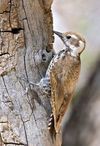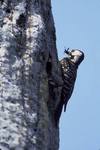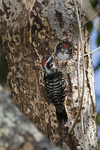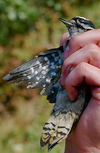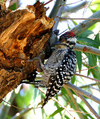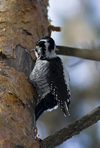Genus Picoides
White-headed woodpecker - The range of the White-headed Woodpecker stretches in the mountains from British Columbia through southern California. They form nests in dead trees or snags and reproduce once per year.
Black-backed Woodpecker - The plumage of adults is black on the head, back, wings and rump. They are white from the throat to the belly; the flanks are white with black bars. Their tail is black with white outer feathers. There is an element of sexual dimorphism in the plumage, with the adult male possessing a yellow cap. Unlike all other woodpeckers except the related American and Eurasian Three-toed Woodpeckers, this species has three-toed feet.
Arizona Woodpecker - This species is known in older field guides as a subspecies of Strickland's Woodpecker. The 42nd supplement of the American Ornithologists Union checklist officially split Strickland's Woodpecker into two species: the northern population in the Sierra Madre Occidental region and the southern population in central Mexico .
Red-cockaded woodpecker - The Red-cockaded Woodpecker's most distinguishing feature is a black cap and nape that encircle large white cheek patches. Rarely visible, except perhaps during the breeding season and periods of territorial defense, the male has a small red streak on each side of its black cap called a cockade, hence its name. The Red-cockaded Woodpecker feeds primarily on ants, beetles, cockroaches, caterpillars, wood-boring insects, and spiders, and occasionally fruit and berries.
American three-toed woodpecker - This woodpecker has a length of 21 cm and a wingspan of 38 cm and closely resembles the Black-backed Woodpecker, which is also three-toed. Until recently, it was considered to be the same species as the Eurasian Three-toed Woodpecker, . Adults are black on the head, wings and rump, and white from the throat to the belly; the flanks are white with black bars. The back is white with black bars and the tail is black with the white outer feathers barred with black. The adult male has a yellow cap.
Nuttall's woodpecker - Nuttall's Woodpecker is common in groves of live oak and chaparral west of the Sierra mountains in the state of California and extends south into the top of the Baja California Peninsula of Mexico.
Downy Woodpecker - The Downy Woodpecker, Picoides pubescens, is the smallest woodpecker in North America. Adults are mainly black on the upper parts and wings, with a white back, throat and belly and white spotting on the wings. There is a white bar above the eye and one below. They have a black tail with white outer feathers barred with black. Adult males have a red patch on the back of the head.
Ladder-backed woodpecker - The Ladder-backed Woodpecker is fairly common in dry brushy areas and thickets and has a rather large range. The species can be found year-round over the southwestern United States , most of Mexico, and locally in Central America as far south as Nicaragua.
Strickland's woodpecker - A quiet and shy bird, Strickland's Woodpeckers are fairly common in their limited range, usually found in pine forests and mixed pine-oak slopes at heights of about 4,500 to 7,000 feet. The Strickland's Woodpecker's range generally follows a thin east-west band in central Mexico from Michoacán to Veracruz.
Three-toed Woodpecker - The adult is 21.5-24 cm in length. It is black on the head, wings and rump, and white from the throat to the belly; the flanks are white with black bars. The back is white with black bars, and the tail is black with the white outer feathers barred with black. The adult male has a yellow cap.
Hairy Woodpecker - The Hairy Woodpecker is a medium-sized woodpecker, averaging approximately 250 mm in length with a 380 mm wingspan.


